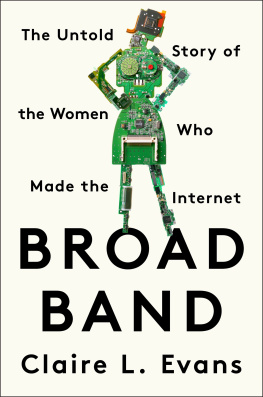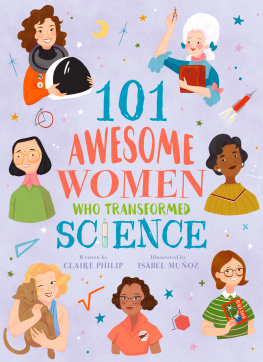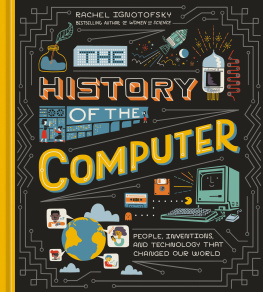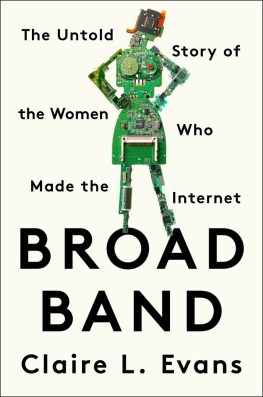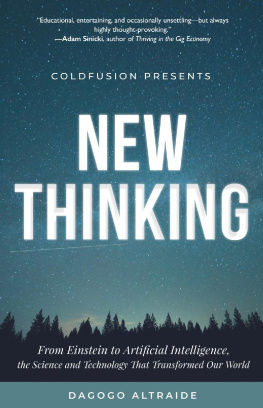Copyright 2018 by Claire L. Evans
Penguin supports copyright. Copyright fuels creativity, encourages diverse voices, promotes free speech, and creates a vibrant culture. Thank you for buying an authorized edition of this book and for complying with copyright laws by not reproducing, scanning, or distributing any part of it in any form without permission. You are supporting writers and allowing Penguin to continue to publish books for every reader.
: Grace Murray Hopper Collection, Archives Center, National Museum of American History, Smithsonian Institution
: U.S. Army Photo, courtesy of the University of Pennsylvania Archives.
Introduction
THE DELL
When I was younger, I had a Dell.
It was a beige box fastened to the Internet with a 28.8K modem that screeched with every connection. Its keys were as tall as sugar cubes and slightly concave. The installation occupied the elbow of an L-shaped desk in my bedrooms inner sanctum. Over the years, I laid stickers in geological strata across the white laminate of my desk. Peeled one at a time, theyd have revealed earlier versions of the girl sticking them, like a candy passing through its flavors as it melts in the mouth. A teenage girls room is a cockpit, an altar, and a womb: it contains her most sacred things, and it holds her as she grows, until eventually it ejects her into the world.
The Dell underwent its own changes. It ran every Microsoft operating system from MS DOS to Windows 95. The DOS era was wonderful: games on floppy disk, terminal commands. Over time, my monitors blunt plastic bezel thickened with coats of glitter nail polish and Post-It notes. GET A LIFE, I wrote across the Dells frame, in Sharpie, in anger, in devotion.
When the Internet came into my life, it was as though my monitor became a glass gate. It opened to an infinite channel. When the modem stuttered, Id shower it in compliments: You are such a good modem, and I believe you can do anything. It was my own compulsive folk tradition. I believed, then, that information, like people, needed support on its journey across the world. In my early years online, I learned how to write HTML and built rudimentary sites honoring my favorite bands. I sent passionate e-mails to estranged summer camp friends. I found answers to the questions I was too shy to ask. I made pen pals I was afraid of meeting. I journaled in pocket communities now obsolete. In short, I became myself, enjoying the freedoms the computer afforded me, freedoms both fromisolation, shyness, ignoranceand tolearn, experiment, discover, and play.
I abandoned the Dell when I left for college with a Sony VAIO, one of those tragic interstitial laptop models that will likely populate future museums of technology, with a detachable base that served mostly to heat the tops of my thighs. Like most consumer electronics in the United States, the Dell was likely landfilled, or else dispatched by container ship to China, Malaysia, India, or Kenya, where it was disarticulated like a chicken carcass, cables snipped, guts stripped of valuable metals and ores. Today I think about how the glitter-encrusted monitor must have looked to the underpaid laborers, working in a toxic field of unprocessed e-waste, who ground my Dell into plastic dust. Even once theyve grown obsolete, computers never fully disappearthey only become somebody elses problem. Being mass-produced, they form part of our cultural memory, avatars, like my Dell, of childhood landscapes, or, like the Macintosh I never had, of personal computing as a whole. Doubtless this is why we so often consider the history of technology as a row of progressively smarter machines: from Chinese abaci to room-sized cabinets tended by pliant workers, from refrigerators with cathode-ray screens to ever-smaller incarnations of silicon and plastic, dwindling finally to the familiar handheld pane of glass. Anywhere along the line, its tempting to eulogize the box. To point to one and say, The people who made this changed the world. This story is not about those people.
This is a book about women.
Its also a book about the use of computers, real and potential. This is not to say that men make and women usefar from itonly that the technological history were usually told is one about men and machines, ignoring women and the signals they compose. Female mental labor was the original information technology, and women elevated the rudimentary operation of computing machines into an art called programming. They gave language to the box. They wrestled brute mainframes into public service, showing how the products of industry could serve the people, if the intent was there. When the Internet was still an unruly assortment of hosts, they built protocols to direct the flow of traffic and help it grow. Before the World Wide Web came into our lives, female academics and computer scientists created systems to turn vast storehouses of digital information into knowledge; we abandoned those in favor of brute simplicity. Women built empires in the dot-com era, and they were among the earliest to establish and grow virtual communities. The lessons they learned in the process would serve us well today, if wed listen.
None of this quantifies cleanly, which makes these womens contributions to computing difficult to catalog and even harder to memorialize. Although this book owes a debt of gratitude to the fine historical research it cites, I also drew from first-person accounts given by the women in these pages and from the fragmentary documentation characteristic of technological history: screenshots, chat logs, abandonware, outdated manuals, and eroded Web pages. Ive done my best to explore what software artifacts remain, learning Unix commands and the social conventions of old-world online culture with the diligence of a student abroad. May the servers whir long enough to support more virtual tourism, because these places will become only more precarious with time. An irony: even as computer memory multiplies, our ability to hold on to personal memories remains a matter of will, bounded by the skull and expanded only by our capacity to tell stories.
There are technical women in these pages, some of the brightest programmers and engineers in the history of the medium. There are academics and hackers. And there are culture workers, too, pixel pushers and game designers and the self-proclaimed biggest bitch in Silicon Alley. Wide as their experiences are, theyve all got one thing in common. They all care deeply about the user. They are never so seduced by the box that they forget why its there: to enrich human life. If youre looking for women in the history of technology, look first where it makes life better, easier, and more connected. Look for the places where form gives way to function. A computer is a machine that condenses the world into numbers to be processed and manipulated. Making this comprehensible to as many people as possible, regardless of technical skill, is not an essentially feminine pursuit. Nothing is. That being said, the women I talked to all seemed to understand it implicitly and to value it as fundamental, inalienable, and right.

